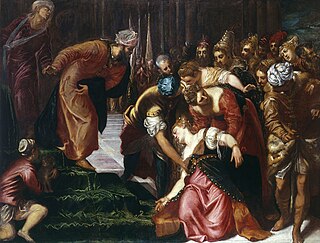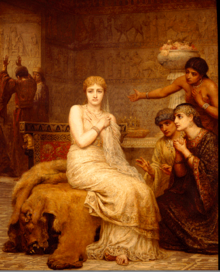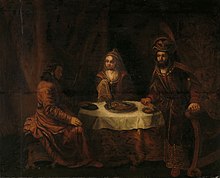
The Book of Esther, also known in Hebrew as "the Scroll", is a book in the third section of the Hebrew Bible. It is one of the Five Scrolls in the Hebrew Bible and later became part of the Christian Old Testament. The book relates the story of a Jewish woman in Persia, born as Hadassah but known as Esther, who becomes queen of Persia and thwarts a genocide of her people.

Esther, originally Hadassah, is the eponymous heroine of the Book of Esther in the Hebrew Bible. According to the biblical narrative, which is set in the Achaemenid Empire, the Persian king Ahasuerus falls in love with Esther and marries her. His grand vizier Haman is offended by Esther's cousin and guardian Mordecai because of his refusal to bow before him; bowing in front of another person was a prominent gesture of respect in Persian society, but deemed unacceptable by Mordecai, who believes that a Jew should only express submissiveness to God. Consequently, Haman plots to have all of Persia's Jews killed, and eventually convinces Ahasuerus to permit him to do so. However, Esther foils the plan by revealing and decrying Haman's plans to Ahasuerus, who then has Haman executed and grants permission to the Jews to take up arms against their enemies; Esther is hailed for her courage and for working to save the Jewish nation from eradication.

Ahasuerus is a name applied in the Hebrew Bible to three rulers of Ancient Persia and to a Babylonian official first appearing in the Tanach in the Book of Esther and later in the Christian Book of Tobit. It is a transliteration of either Xerxes I or Artaxerxes; both are names of multiple Achaemenid dynasty Persian kings.

Artaxerxes I was the fifth King of Kings of the Achaemenid Empire, from 465 to December 424 BC. He was the third son of Xerxes I.

Mordecai is one of the main personalities in the Book of Esther in the Hebrew Bible. He is described in Tanna Devei Eliyahu as being the son of Jair, of the tribe of Benjamin and member of the Sanhedrin. Mordecai was also the cousin and guardian of Esther, who became queen of Persia under the reign of Ahasuerus. Mordecai's loyalty and bravery are highlighted in the story as he helps Esther foil the plot of Haman, the king's Vizier, to exterminate the Jewish people. His story is celebrated in the Jewish holiday of Purim, which commemorates his victory. However, since the 1890s, some academics have suggested that Purim originated from a Babylonian or Persian myth or festival, noting the lack of overt religious elements in the story, with a hypothesis that “[The Book of] Esther [is] a historicized myth or ritual”.

Purim is a Jewish holiday that commemorates the saving of the Jewish people from annihilation at the hands of an official of the Achaemenid Empire named Haman, as it is recounted in the Book of Esther.
Amestris was a Persian queen, the wife of Xerxes I of Persia, mother of Achaemenid King of Kings Artaxerxes I of Persia.

Haman is the main antagonist in the Book of Esther, who according to the Hebrew Bible was an official in the court of the Persian empire under King Ahasuerus, commonly identified as Xerxes I but traditionally equated with Artaxerxes I or Artaxerxes II. As his epithet Agagite indicates, Haman was a descendant of Agag, the king of the Amalekites. Some commentators interpret this descent to be symbolic, due to his similar personality.
According to the biblical book of Esther, Memucan was one of the seven vice-regents of the Persian King Ahasuerus.
Damaspia was a queen of Persia, wife of King Artaxerxes I, and mother of Xerxes II, his legitimate heir. She was Persian.

Seder Olam Rabbah is a 2nd-century CE Hebrew language chronology detailing the dates of biblical events from creation to Alexander the Great's conquest of Persia. It adds no stories beyond what is in the biblical text, and addresses such questions as the age of Isaac at his binding and the number of years that Joshua led the Israelites. Tradition considers it to have been written about 160 CE by Jose ben Halafta, but it was probably also supplemented and edited at a later period.

Esther was the chief character in the Book of Esther. She is counted among the prophetesses of Israel. Allusions in rabbinic literature to the Biblical story of Esther contain various expansions, elaborations and inferences beyond the text presented in the book of the Bible.
Esther is an American opera in 3 acts composed by Hugo Weisgall, with a libretto by Charles Kondek. Esther was premiered by the New York City Opera in October 1993. The opera is about Esther's struggle as she becomes the queen of Persia, and her heroic triumph over the evil Prime Minister Haman and his plot of exterminating the Jews.

Esther, also known as The Bible: Esther, is a 1999 American-Italian-German television film based on the Book of Esther, directed by Raffaele Mertes and starring Louise Lombard as Queen Esther, F. Murray Abraham as Mordechai, Jürgen Prochnow as Haman, Thomas Kretschmann as King Achashverosh and Ornella Muti as Vashti.

One Night with the King is a 2006 American religious epic film produced by Matt Crouch and Laurie Crouch of Gener8Xion Entertainment, directed by Michael O. Sajbel, and starring Peter O'Toole, Tiffany Dupont, John Rhys-Davies, and Luke Goss.

The Book of Esther is a 2013 American biblical-drama film directed by David A. R. White and starring Jen Lilley as Esther. The film portrays a Jewish girl, Esther, who is chosen as the new queen consort to King Xerxes I of Persia and her efforts to stop evil Lord Haman's plot to exterminate the Jews. The film is loosely based on the biblical tale of the Book of Esther. It was released on June 11, 2013, in the United States as a direct-to-TV special.

Vashti is a 1879 oil on canvas painting by the English painter Edwin Long depicting a character in the book of Esther in the Hebrew Bible. Long was greatly influenced by the paintings of Velasquez and other Spanish masters, and his earlier pictures. It was housed in the Museum and Gallery at Bob Jones University.

Ezra 4 is the fourth chapter of the Book of Ezra in the Old Testament of the Christian Bible, or the book of Ezra–Nehemiah in the Hebrew Bible, which treats the book of Ezra and book of Nehemiah as one book. Jewish tradition states that Ezra is the author of Ezra–Nehemiah as well as the Book of Chronicles, but modern scholars generally accept that a compiler from the 5th century BCE is the final author of these books. The section comprising chapter 1 to 6 describes the history before the arrival of Ezra in the land of Judah in 468 BCE. This chapter records the opposition of the non-Jews to the re-building of the temple and their correspondence with the kings of Persia which brought a stop to the project until the reign of Darius the Great.

Esther 1 is the first chapter of the Book of Esther in the Hebrew Bible or the Old Testament of the Christian Bible. The author of the book is unknown and modern scholars have established that the final stage of the Hebrew text would have been formed by the second century BCE. Chapters 1 and 2 form the exposition of the book. This chapter records the royal banquets of the Persian king Ahasuerus until the deposal of queen Vashti.

Esther 2 is the second chapter of the Book of Esther in the Hebrew Bible or the Old Testament of the Christian Bible. The author of the book is unknown and modern scholars have established that the final stage of the Hebrew text would have been formed by the second century BCE. Chapters 1 and 2 form the exposition of the book. This chapter introduces Mordecai and his adoptive daughter, Esther, whose beauty won the approval of the king Ahasuerus, and she was crowned the queen of Persia. Given information from Mordecai, Esther warned the king of an assassination plan, so that the would-be assassins were executed on the gallows, and the king owed Mordecai his life.

















